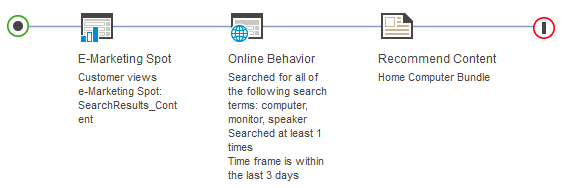Target: Online Behavior
Use this target in web and dialog activities, and in search rules, to target customers whose recorded behavior while shopping on the site over time meets certain criteria. The recorded behavior of our customers can provide you with important clues about their interests. We can use these clues to personalize marketing messages.We can use two different types of recorded behavior in this target:
- Scenario 1: Customer searched for specific keywords
- Scenario 2: Customer viewed pages that contain a specific parameter on the page URL
To target customers according to parts of the catalog they browsed, use the Catalog Browsing Behavior target instead.
Scenario 1: Customer searched for specific keywords
For e-Marketing Spots on a search results page, we can use this target to display something relevant to what a customer searched for in their recorded online behavior on the site. We can also use this target in a dialog activity, for example, to email information about a promotion to a customer who searched multiple times for a certain product.Example
When a customer
views the e-Marketing Spot on the search results page, if the customer searched
for computer
and monitor
and speaker
within the last 3 days, then display an advertisement for a home computer bundle.

Guidelines for using this target in scenario 1
When you set up this target, we must specify which keywords the customer searched for. We can specify one or more exact search keywords, portions of keywords, or a series of keywords. We can also specify:- The number of times the customer searched for the keywords.
- The time frame in which the customer searched for the keywords, for example, within the last two days.
Alternatively, we can use this target to target customers whose recorded behavior does not include the keyword searches that you specify.
To determine when a customer used the search terms specified for the target, the server looks for a match in the searchTerm value on the CatalogSearchResultView URL. If the store uses page view names or URL parameter names that are different from the default, then the target will not work unless a developer performs some customization steps.
Scenario 2: Customer viewed pages that contain a specific parameter on the page URL
Use this scenario to target customers whose recorded behavior includes viewing pages with a specific parameter on the page URL.Example
Your company has a Facebook fan page that contains various links back to the store. When a fan clicks any of the links 3 times, we want to thank the fan by displaying an ad that contains a promotion code. The fan can use the promotion code to get 10% off an order.- On your Facebook fan page, you add various links to the storefront. You embed the following parameter in each of the links:
referral=facebookfanpage
For example, a link from your fan page to your home page looks like this example:
http://www.aurora.com/shop/en/aurora?referral=facebookfanpage
- To reward Facebook fans, you run the following web activity in several e-Marketing Spots for
fans who clicked any of the fan page links at least three times:
When a customer views the e-Marketing Spot in the first row of the home page or on the search results page: If the customer's recorded behavior on the site includes visiting a page with the parameter referral=facebookfanpage, display an ad containing the promotion code for Facebook fans.

This Online Behavior target scenario is similar to the Current Page target scenario that also uses a parameter on the page URL. However, with the Current Page target, your only option is to display your targeted marketing message in the e-Marketing Spot on the landing page from the link that you included on the Facebook page. With the Online Behavior target, we can use other e-Marketing Spots on the store pages, if the customer clicked the link that you included on the Facebook page the number of times you specified. Clicking the link is part of the customer's recorded online behavior, and therefore the customer meets the target criteria as they shops on other pages. This way, we can communicate your marketing message on multiple store pages.
Guidelines for using this target in scenario 2
When you set up this target:- We can specify only one parameter name to match, but we can specify one or more parameter values.
- We can specify that the server must match the exact parameter value, a portion of the value, or any value. The parameter value cannot contain a comma, which is a reserved character.
We can also specify:
- The number of times the customer must view a page with the specified parameter in the page URL. The customer must view the page at least one time for the target to match.
- The time frame in which the customer must view a page with the specified parameter in the page URL, for example, within the last two days.
Alternatively, we can use this target to target customers whose recorded behavior does not include viewing pages that contain the parameter that you specify.
Prerequisite for using this target
Make sure that the site is configured to support the Management Center marketing features.
Related concepts
Target: Customer Segment
Target: Shopping Cart
Target: Purchase History
Target: Catalog Browsing Behavior
Target: External Site Referral
Target: Social Commerce Participation
Target: Day and Time
Target: Search Criteria and Result